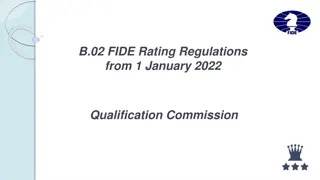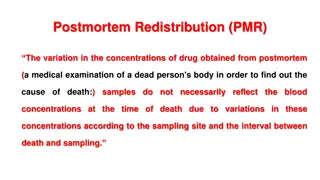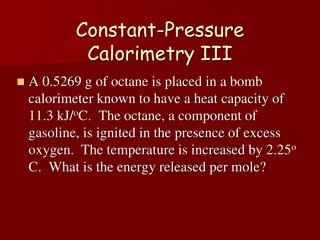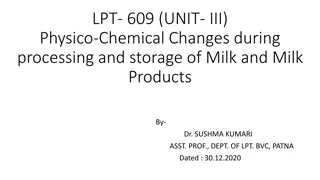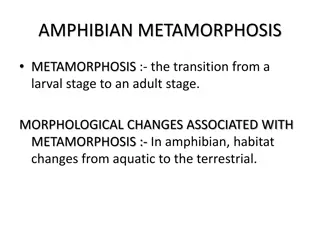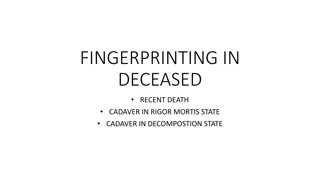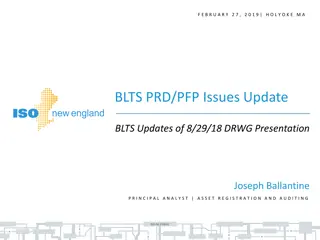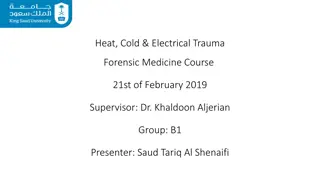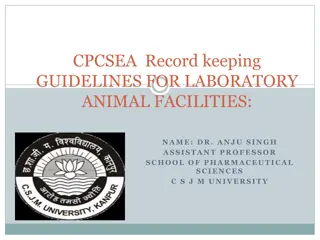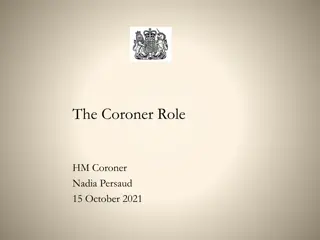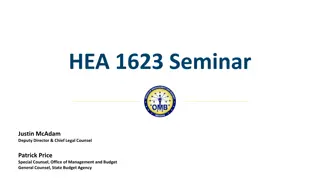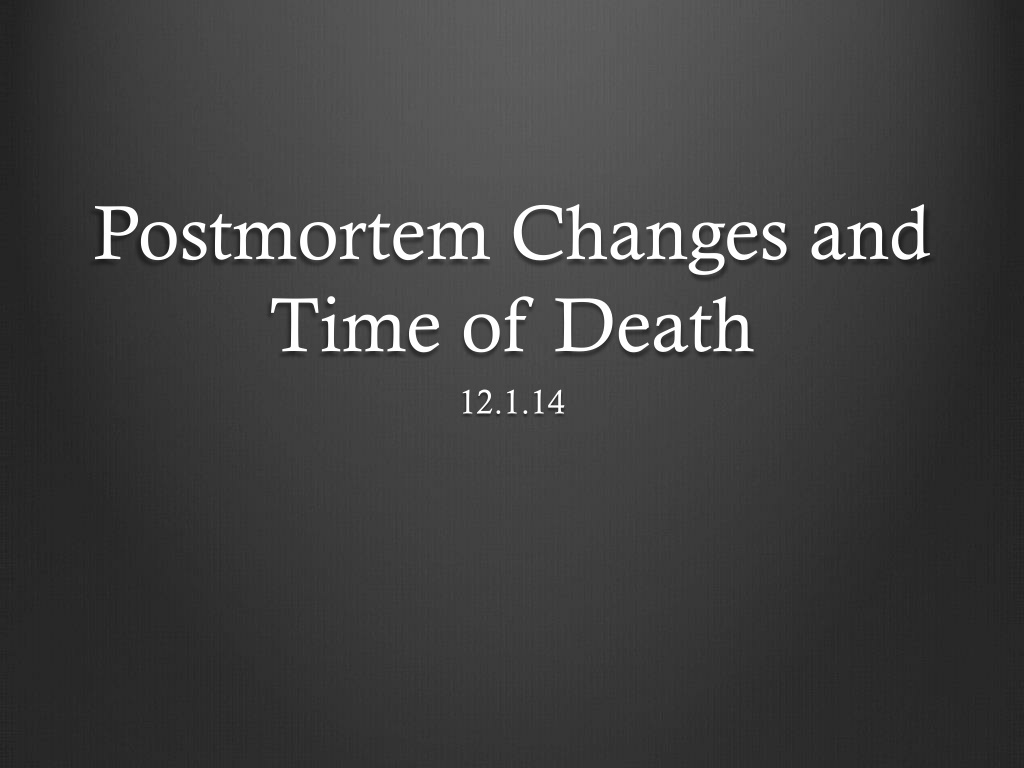
Understanding Postmortem Changes and Time of Death
Explore the postmortem changes and processes involved in determining the time of death. Learn about clinical death, legal death, immediate postmortem changes, and early postmortem changes like algor mortis, livor mortis, and rigor mortis. Understand the significance of observing respiratory, circulatory, and central nervous systems in determining death.
Download Presentation

Please find below an Image/Link to download the presentation.
The content on the website is provided AS IS for your information and personal use only. It may not be sold, licensed, or shared on other websites without obtaining consent from the author. Download presentation by click this link. If you encounter any issues during the download, it is possible that the publisher has removed the file from their server.
E N D
Presentation Transcript
Postmortem Changes and Time of Death 12.1.14
Postmortem = after death Necessary interdependent systems for life: Respiratory system Circulatory system Central nervous system Clinical death: All three of the above systems must be non-functioning Legal death: Can be determined based on absence of neurological function despite lack of clinical death
Determination of Clinical Death Observation for breathing Auscultation for heart beat Palpation for a pulse Instrumentation Electroencephalogram measures brain activity Can be misleading in cases of hypothermia due to depressed body functions Electrocardiogram
Immediate Postmortem Changes
Immediate Postmortem Changes Cessation of respiration Cessation of circulation Muscular relaxation Loss of reflexes Skin pallor (paleness loss of natural color) Dilated pupils
Early Postmortem Changes (not immediate) Apparent after one or two hours:
Early Postmortem Changes (not immediate) Apparent after one or two hours: Algor mortis Livor mortis Rigor mortis
Early Postmortem Changes (not immediate) Apparent after one or two hours: Algor mortis body cooling Livor mortis discoloration due to blood settling Rigor mortis stiffening of muscles
Algor Mortis Normal body temperature varies Body cooling does not occur at a uniform rate Under average conditions, the body cools at the rate of about 2.0-2.5oF per hour for the first few hours, then slower afterwards. Skin cools more rapidly than the inside of the body that is why the inner body core temperature should be taken at the scene.
Modes of Heat Loss Conduction Radiation Convection -
Modes of Heat Loss Conduction Heat transfer by items in contact Radiation Infrared heat transfer Convection Heat transfer by air movement
Factors Affecting Algor Mortis Time Environmental temperature Location of body In water the temperature of a body would drop more rapidly, on the ground more slowly due to insulating effect of soil, etc. Body type and clothing obesity or heavy clothing slows cooling due to insulation Humidity and air currents body exposed to wind will cool more rapidly
Livor Mortis Discoloration of the skin in lower regions of the body Usual color of lividity is red-purple Begins immediately at death due to lack of circulation Blood settles due to gravity Small vessels and capillaries become congested with blood
Livor Mortis Not generally apparent for 1-2 hours Fixed (or permanent) after 6-12 hours Blood will not flow to a new region if the body is moved after livor is fixed, thus inappropriate lividity (livor mortis in an unexpected location) is an indication that the body has been moved at least 6-12 hours after death
Livor Mortis Pressure can effect appearance of livor mortis, as pressure can displace blood in regions that should otherwise be darkened
Livor discoloration Red-purple Normal Pink Cyanide or cold Cherry-red CO or fluoro-acetate Brown Nitrites or methemoglobin Note: Livor can be confused with bruises livor can be drained, but blood from bruises cannot since the blood has infiltrated the surrounding tissues and is no longer in the capillaries
Livor Mortis While livor mortis is a poor indicator of time of death, it is excellent for determining the place/position of death
Rigor Mortis A post-mortem stiffening of the muscles due to lactic acid causing a cross-linkage between actin and myosin (the proteins involved in muscle contraction)
Rigor Mortis ATP generally breaks this cross-linkage, but ATP is depleted shortly after death Rigor persists until decomposition begins to break down the protein complex, thus relaxing the muscles
Factors Affecting Rigor Rigor is generally noticeable at ~3 hours, but can be accelerated by: Environmental heat Fever in victim prior to death Some drugs Exercise prior to death Can be slowed by: Cold environment Emaciation
Rigor/Algor at Average Temperatures Body warm and flaccid: <3 hours Warm and rigid: 3-8 hours Cold and rigid: 8-36 hours Cold and flaccid: >36 hours
Other time of death indicators? Insects various insects deposit eggs and those eggs develop and known rates Stomach contents -
Other time of death indicators? Insects various insects deposit eggs and those eggs develop and known rates Stomach contents food takes approximately two hours to digest and then be emptied from the stomach under normal conditions
Late changes in Death Decomposition Adipocere Mummification Skeletonization
Decomposition Two processes drive decomposition: Autolysis Putrefaction
Decomposition Two processes drive decomposition: Autolysis Body s own digestive enzymes begin to break down cellular proteins and other molecules. Begins immediately after death. Putrefaction
Decomposition Two processes drive decomposition: Autolysis Body s own digestive enzymes begin to break down cellular proteins and other molecules. Begins immediately after death. Putrefaction Decomposition driven by bacterial activity. This is the primary factor causing decomposition.
Putrefaction process Green discoloration of abdomen begins at 24-36 hours after death Marbled appearance often noticeable due to intravascular hydrogen sulfide producing bacteria Gas formation and bloating noticeable at 60-70 hours causes blisters and skin slippage, loss of hair and nails
Putrefaction Liver filled with holes why??
Putrefaction Liver filled with holes due to invasion and proliferation of gas-producing bacteria during decomposition
Factors affecting decomposition Temperature Humidity Body location: Decomposition rates on land are generally twice as fast as in water, and eight times as fast as those when a body is buried due to lack of oxygen and lower temperatures
Alterations to normal decomposition Adipocere Grave Wax Conversion of fats to oleic, palmitic, or stearic acids (these are waxes, not fats) Occurs in damp, warm, anaerobic (no oxygen present) environments Due to lack of oxygen, other decomposition changes do not occur
Mummification The process of desiccation of a body Occurs in exceedingly dry conditions Normal decomposition processes prevented due to lack of water necessary for bacterial growth






